A Novel Approach to Simulating Realistic Exoskeleton Behavior in Response to Human Motion
Abstract
:1. Introduction
2. Human-Motion-Based Approach for Exoskeleton Simulation
2.1. Multibody Model of a Shoulder Exoskeleton
2.2. Interface to Human Motion
2.3. Human–Exoskeleton Interaction Model
3. Validation of Human-Motion-Based Simulation Approach
4. Simulative Optimization of the Support Profile
5. Results
5.1. Comparison of Simulated and Measured Variables
5.1.1. Exoskeleton Motion
5.1.2. Interaction Force at Arm Interface
5.2. Comparison of Unsupported and Supported Motion Simulation
5.3. Task-Specific Support Profile
6. Discussion
6.1. Comparison of Simulated and Measured Variables
6.2. Comparison of Unsupported and Supported Motion Simulation
6.3. Task-Specific Support Profile
7. Conclusions
Supplementary Materials
Author Contributions
Funding
Institutional Review Board Statement
Informed Consent Statement
Data Availability Statement
Conflicts of Interest
References
- Fournier, B.N.; Lemaire, E.D.; Smith, A.J.J.; Doumit, M. Modeling and Simulation of a Lower Extremity Powered Exoskeleton. IEEE Trans. Neural Syst. Rehabil. Eng. 2018, 26, 1596–1603. [Google Scholar] [CrossRef] [PubMed]
- Fritzsche, L.; Gärtner, C.; Spitzhirn, M.; Galibarov, P.E.; Damsgaard, M.; Maurice, P.; Babič, J. Assessing the Efficiency of Industrial Exoskeletons with Biomechanical Modelling—Comparison of Experimental and Simulation Results. In Proceedings of the 21st Congress of the International Ergonomics Association (IEA 2021), Online, 13–18 June 2021; Black, N.L., Neumann, W.P., Noy, I., Eds.; Springer International Publishing: Cham, Switzerland, 2022; pp. 353–357. [Google Scholar]
- Agarwal, P.; Neptune, R.R.; Deshpande, A.D. A Simulation Framework for Virtual Prototyping of Robotic Exoskeletons. J. Biomech. Eng. 2016, 138, 061004. [Google Scholar] [CrossRef] [PubMed]
- Guan, X.; Ji, L.; Wang, R.; Huang, W. Optimization of an Unpowered Energy-Stored Exoskeleton for Patients with Spinal Cord Injury. In Proceedings of the 2016 38th Annual International Conference of the IEEE Engineering in Medicine and Biology Society (EMBC), Orlando, FL, USA, 16–20 August 2016; pp. 5030–5033. [Google Scholar]
- Zhou, L.; Li, Y.; Bai, S. A Human-Centered Design Optimization Approach for Robotic Exoskeletons through Biomechanical Simulation. Robot. Auton. Syst. 2017, 91, 337–347. [Google Scholar] [CrossRef]
- Tröster, M.; Wagner, D.; Müller-Graf, F.; Maufroy, C.; Schneider, U.; Bauernhansl, T. Biomechanical Model-Based Development of an Active Occupational Upper-Limb Exoskeleton to Support Healthcare Workers in the Surgery Waiting Room. Int. J. Environ. Res. Public Health 2020, 17, 5140. [Google Scholar] [CrossRef]
- Ferrati, F.; Bortoletto, R.; Pagello, E. Virtual Modelling of a Real Exoskeleton Constrained to a Human Musculoskeletal Model. In Biomimetic and Biohybrid Systems; Lepora, N.F., Mura, A., Krapp, H.G., Verschure, P.F.M.J., Prescott, T.J., Eds.; Springer: Berlin/Heidelberg, Germany, 2013; pp. 96–107. [Google Scholar]
- Imamura, Y.; Tanaka, T.; Suzuki, Y.; Takizawa, K.; Yamanaka, M. Motion-Based-Design of Elastic Material for Passive Assistive Device Using Musculoskeletal Model. J. Robot. Mechatron. 2011, 23, 978–990. [Google Scholar] [CrossRef]
- Kuhn, J.; Hu, T.; Schappler, M.; Haddadin, S. Dynamics Simulation for an Upper-Limb Human-Exoskeleton Assistance System in a Latent-Space Controlled Tool Manipulation Task. In Proceedings of the 2018 IEEE International Conference on Simulation, Modeling, and Programming for Autonomous Robots (SIMPAR), Brisbane, QLD, Australia, 16 May 2018; pp. 158–165. [Google Scholar]
- De Kruif, B.J.; Schmidhauser, E.; Stadler, K.S.; O’Sullivan, L.W. Simulation Architecture for Modelling Interaction Between User and Elbow-Articulated Exoskeleton. J. Bionic Eng. 2017, 14, 706–715. [Google Scholar] [CrossRef]
- Khamar, M.; Edrisi, M.; Zahiri, M. Human-Exoskeleton Control Simulation, Kinetic and Kinematic Modeling and Parameters Extraction. MethodsX 2019, 6, 1838–1846. [Google Scholar] [CrossRef]
- Mosconi, D.; Nunes, P.F.; Ostan, I.; Siqueira, A.A.G. Design and Validation of a Human-Exoskeleton Model for Evaluating Interaction Controls Applied to Rehabilitation Robotics. In Proceedings of the 2020 8th IEEE RAS/EMBS International Conference for Biomedical Robotics and Biomechatronics (BioRob), New York, NY, USA, 29 November–1 December 2020; pp. 629–634. [Google Scholar]
- Chen, J.; Zhang, X.; Zhu, L. Kinematics Analysis and Three-Dimensional Simulation of the Rehabilitation Lower Extremity Exoskeleton Robot. arxiv 2014, arXiv:1401.6517. [Google Scholar] [CrossRef]
- Ostraich, B.; Riemer, R. Simulation of a Passive Knee Exoskeleton for Vertical Jump Using Optimal Control. IEEE Trans. Neural Syst. Rehabil. Eng. 2020, 28, 2859–2868. [Google Scholar] [CrossRef]
- Inkol, K.A.; McPhee, J. Assessing Control of Fixed-Support Balance Recovery in Wearable Lower-Limb Exoskeletons Using Multibody Dynamic Modelling. In Proceedings of the 2020 8th IEEE RAS/EMBS International Conference for Biomedical Robotics and Biomechatronics (BioRob), New York, NY, USA, 29 November–1 December 2020; pp. 54–60. [Google Scholar]
- Koch, H.; Mombaur, K. ExoOpt—A Framework for Patient Centered Design Optimization of Lower Limb Exoskeletons. In Proceedings of the 2015 IEEE International Conference on Rehabilitation Robotics (ICORR), Singapore, 11–14 August 2015; pp. 113–118. [Google Scholar]
- Low, K.H.; Liu, X.; Yu, H. Design and Implementation of NTU Wearable Exoskeleton as an Enhancement and Assistive Device. Appl. Bionics Biomech. 2006, 3, 209–225. [Google Scholar] [CrossRef]
- Derman, M.; Soliman, A.F.; Kuru, A.; Cevik, S.C.; Unal, R.; Bebek, O.; Ugurlu, B. Simulation-Based Design and Locomotion Control Implementation for a Lower Body Exoskeleton. In Proceedings of the 2022 IEEE 5th International Conference on Industrial Cyber-Physical Systems (ICPS), Coventry, UK, 24–26 May 2022; pp. 1–6. [Google Scholar]
- Pan, D.; Gao, F.; Miao, Y.; Cao, R. Co-Simulation Research of a Novel Exoskeleton-Human Robot System on Humanoid Gaits with Fuzzy-PID/PID Algorithms. Adv. Eng. Softw. 2015, 79, 36–46. [Google Scholar] [CrossRef]
- Panero, E.; Muscolo, G.G.; Gastaldi, L.; Pastorelli, S. Multibody Analysis of a 3D Human Model with Trunk Exoskeleton for Industrial Applications. In Multibody Dynamics 2019; Kecskeméthy, A., Geu Flores, F., Eds.; Springer International Publishing: Cham, Switzerland, 2020; pp. 43–51. [Google Scholar]
- Wang, J.; Ma, Z.-D.; Hulbert, G.M. A Gluing Algorithm for Distributed Simulation of Multibody Systems. Nonlinear Dyn. 2003, 34, 159–188. [Google Scholar] [CrossRef]
- Tseng, F.-C.; Hulbert, G.M. A Gluing Algorithm for Network-Distributed Multibody Dynamics Simulation. Multibody Syst. Dyn. 2001, 6, 377–396. [Google Scholar] [CrossRef]
- Rustin, C.; Verlinden, O.; Bombled, Q. A Cosimulation T-T Procedure Gluing Subsystems in Multibody Dynamics Simulations. In Proceedings of the ASME 2009 International Design Engineering Technical Conferences and Computers and Information in Engineering Conference; American Society of Mechanical Engineers Digital Collection, San Diego, CA, USA, 30 August–2 September 2009; pp. 83–92. [Google Scholar]
- Otten, B.M.; Weidner, R.; Argubi-Wollesen, A. Evaluation of a Novel Active Exoskeleton for Tasks at or Above Head Level. IEEE Robot. Autom. Lett. 2018, 3, 2408–2415. [Google Scholar] [CrossRef]
- Miehling, J. Musculoskeletal Modeling of User Groups for Virtual Product and Process Development. Comput. Methods Biomech. Biomed. Eng. 2019, 22, 1209–1218. [Google Scholar] [CrossRef] [PubMed]
- Holzbaur, K.R.S.; Murray, W.M.; Delp, S.L. A Model of the Upper Extremity for Simulating Musculoskeletal Surgery and Analyzing Neuromuscular Control. Ann. Biomed. Eng. 2005, 33, 829–840. [Google Scholar] [CrossRef]
- Sänger, J.; Yao, Z.; Schubert, T.; Wolf, A.; Molz, C.; Miehling, J.; Wartzack, S.; Gwosch, T.; Matthiesen, S.; Weidner, R. Evaluation of Active Shoulder Exoskeleton Support to Deduce Application-Oriented Optimization Potentials for Overhead Work. Appl. Sci. 2022, 12, 10805. [Google Scholar] [CrossRef]
- Full Body Modeling with Plug-in Gait—Nexus 2.11 Documentation—Vicon Documentation. Available online: https://docs.vicon.com/display/Nexus211/Full+body+modeling+with+Plug-in+Gait#FullbodymodelingwithPluginGait-MarkerplacementforPlug-inGaitfullbodymodel (accessed on 13 October 2023).
- Miller, S. Simscape Multibody Contact Forces Library. Available online: https://github.com/mathworks/Simscape-Multibody-Contact-Forces-Library (accessed on 18 October 2023).
- Kothari, V.; Gangal, M. Assessment of Frictional Properties of Some Woven Fabrics. IJFTR 1994, 19, 151–155. [Google Scholar]
- Sänger, J.; Wirth, L.; Yao, Z.; Scherb, D.; Miehling, J.; Wartzack, S.; Weidner, R.; Lindenmann, A.; Matthiesen, S. ApOL-Application Oriented Workload Model for Digital Human Models for the Development of Human-Machine Systems. Machines 2023, 11, 869. [Google Scholar] [CrossRef]
- Alizadehkhaiyat, O.; Roebuck, M.M.; Makki, A.T.; Frostick, S.P. Subacromial Impingement Syndrome: An Electromyographic Study of Shoulder Girdle Muscle Fatigue. J. Electromyogr. Kinesiol. 2018, 38, 136–142. [Google Scholar] [CrossRef]
- Maenhout, A.; Dhooge, F.; Van Herzeele, M.; Palmans, T.; Cools, A. Acromiohumeral Distance and 3-Dimensional Scapular Position Change After Overhead Muscle Fatigue. J. Athl. Train. 2015, 50, 281–288. [Google Scholar] [CrossRef]
- Sommer, T.G.; Frost, P.; Svendsen, S.W. Combined Musculoskeletal Pain in the Upper and Lower Body: Associations with Occupational Mechanical and Psychosocial Exposures. Int. Arch. Occup. Environ. Health 2015, 88, 1099–1110. [Google Scholar] [CrossRef]
- Argubi-Wollesen, A. Entwicklung und Biomechanische Evaluation Eines Körpergetragenen Unterstützungssystems (Exoskelett) Für Arbeiten in und Über Kopfhöhe. Ph.D. Dissertation, University of Hamburg, Hamurg, Germany, 2021. [Google Scholar]
- Perreault, E.J.; Crago, P.E.; Kirsch, R.F. Estimation of Intrinsic and Reflex Contributions to Muscle Dynamics: A Modeling Study. IEEE Trans. Biomed. Eng. 2000, 47, 1413–1421. [Google Scholar] [CrossRef]
- Schouten, A.C.; Mugge, W.; van der Helm, F.C.T. NMClab, a Model to Assess the Contributions of Muscle Visco-Elasticity and Afferent Feedback to Joint Dynamics. J. Biomech. 2008, 41, 1659–1667. [Google Scholar] [CrossRef]
- Sakka, S.; Hayot, C.; Lacouture, P. A Generalized 3D Inverted Pendulum Model to Represent Human Normal Walking. In Proceedings of the 2010 10th IEEE-RAS International Conference on Humanoid Robots, Nashville, TN, USA, 6–8 December 2010; pp. 486–491. [Google Scholar]
- Loram, I.D.; Lakie, M. Human Balancing of an Inverted Pendulum: Position Control by Small, Ballistic-like, Throw and Catch Movements. J. Physiol. 2002, 540, 1111–1124. [Google Scholar] [CrossRef]
- Kwon, T.; Hodgins, J. Control Systems for Human Running Using an Inverted Pendulum Model and a Reference Motion Capture Sequence; The Eurographics Association: Eindhoven, The Netherlands, 2010; ISBN 978-3-905674-27-9. [Google Scholar]
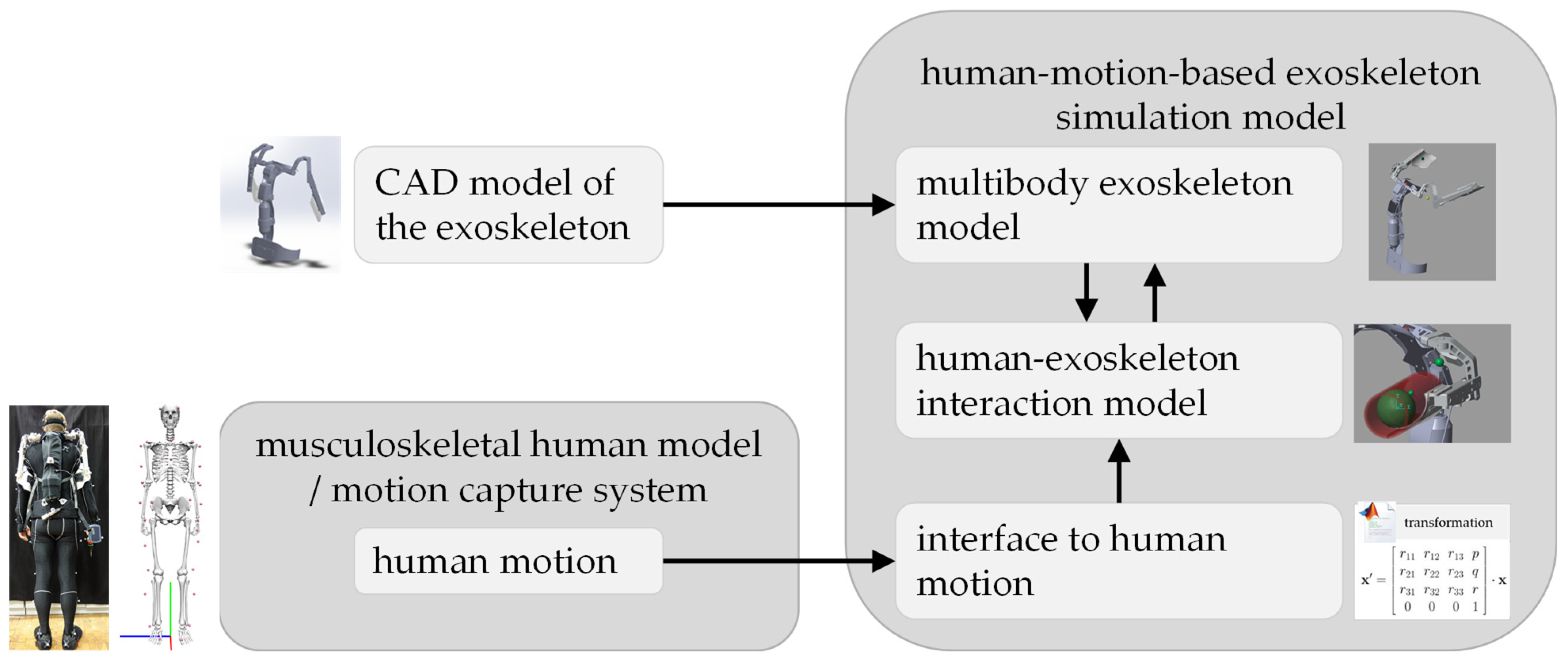



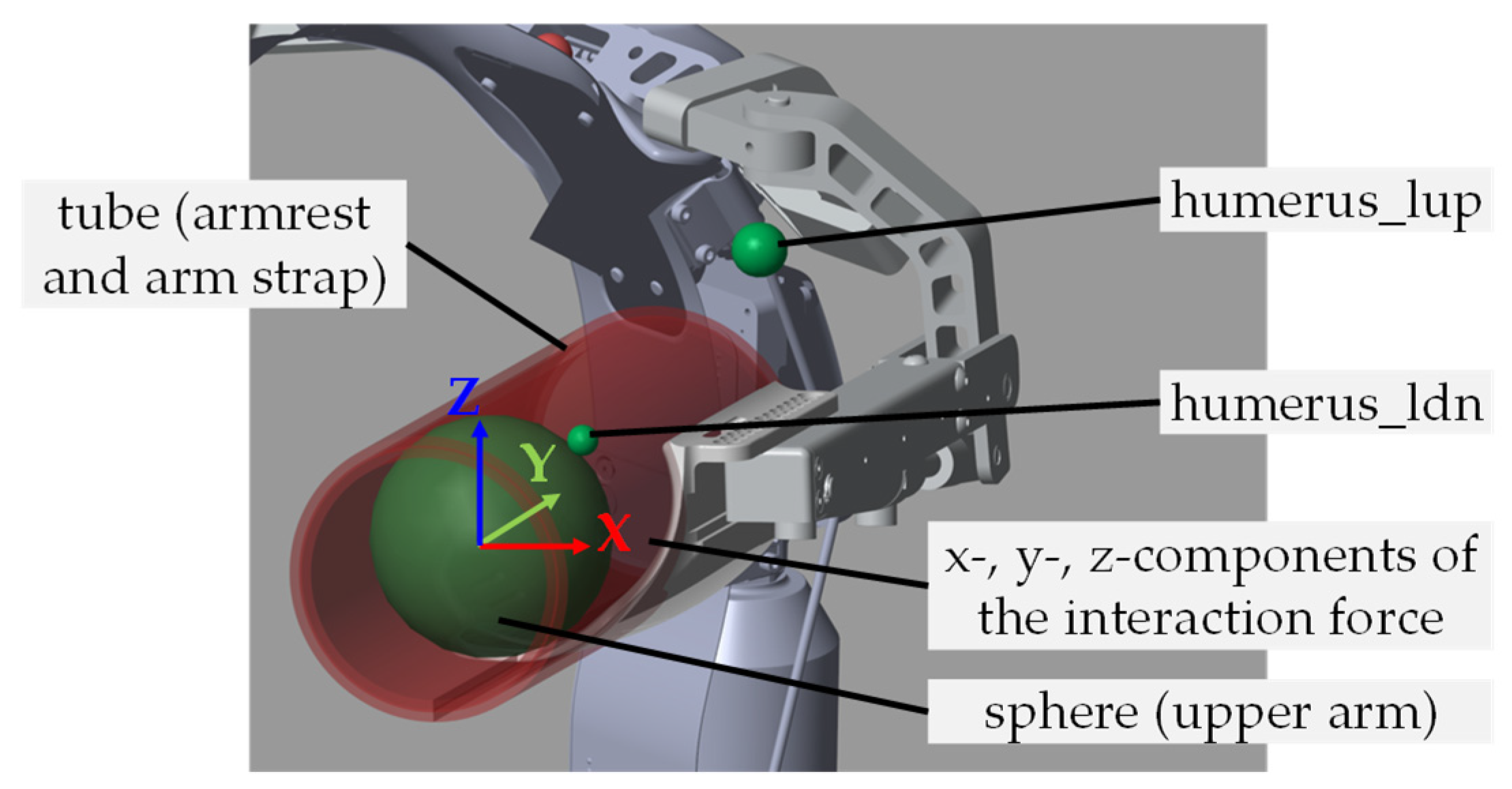
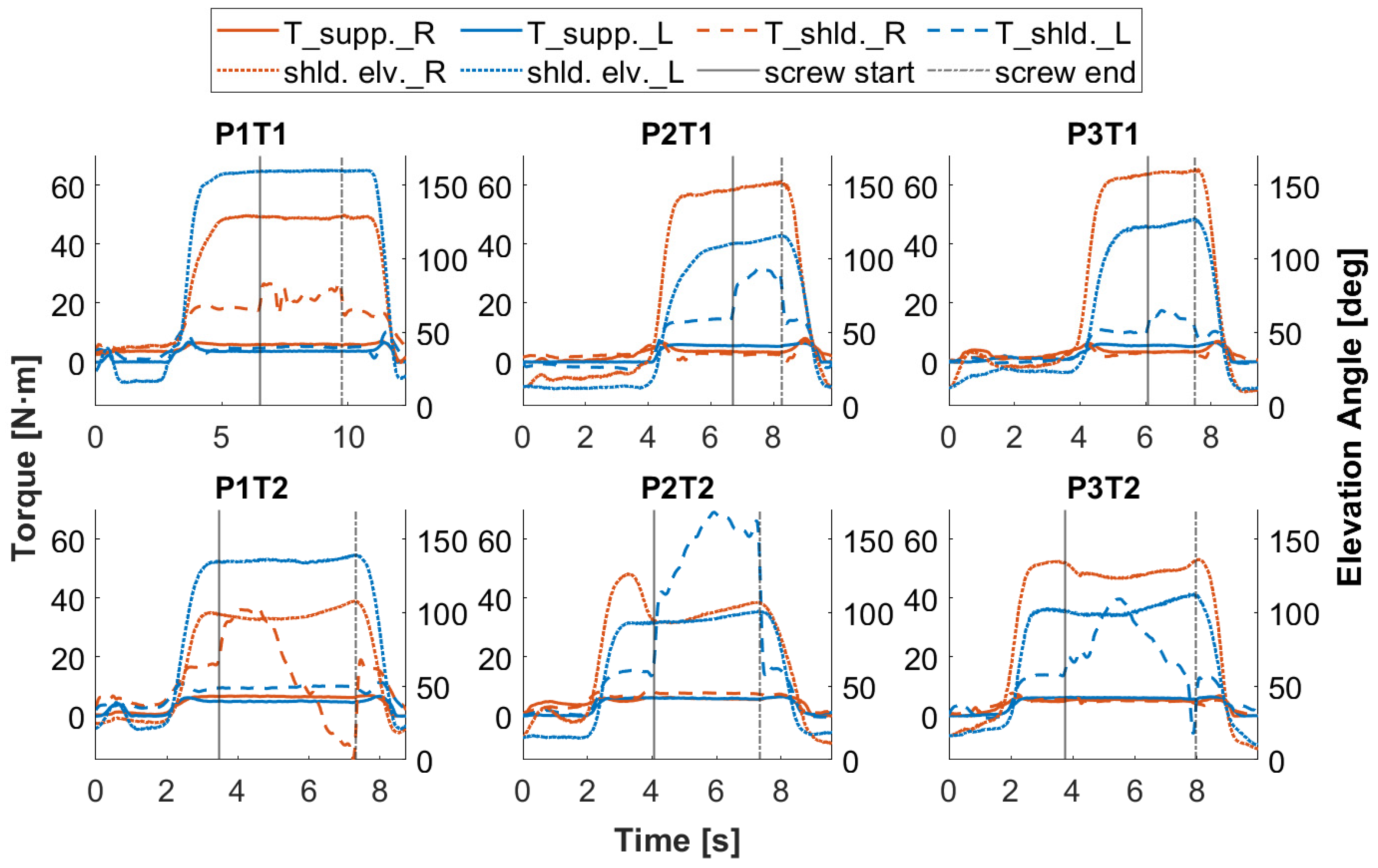



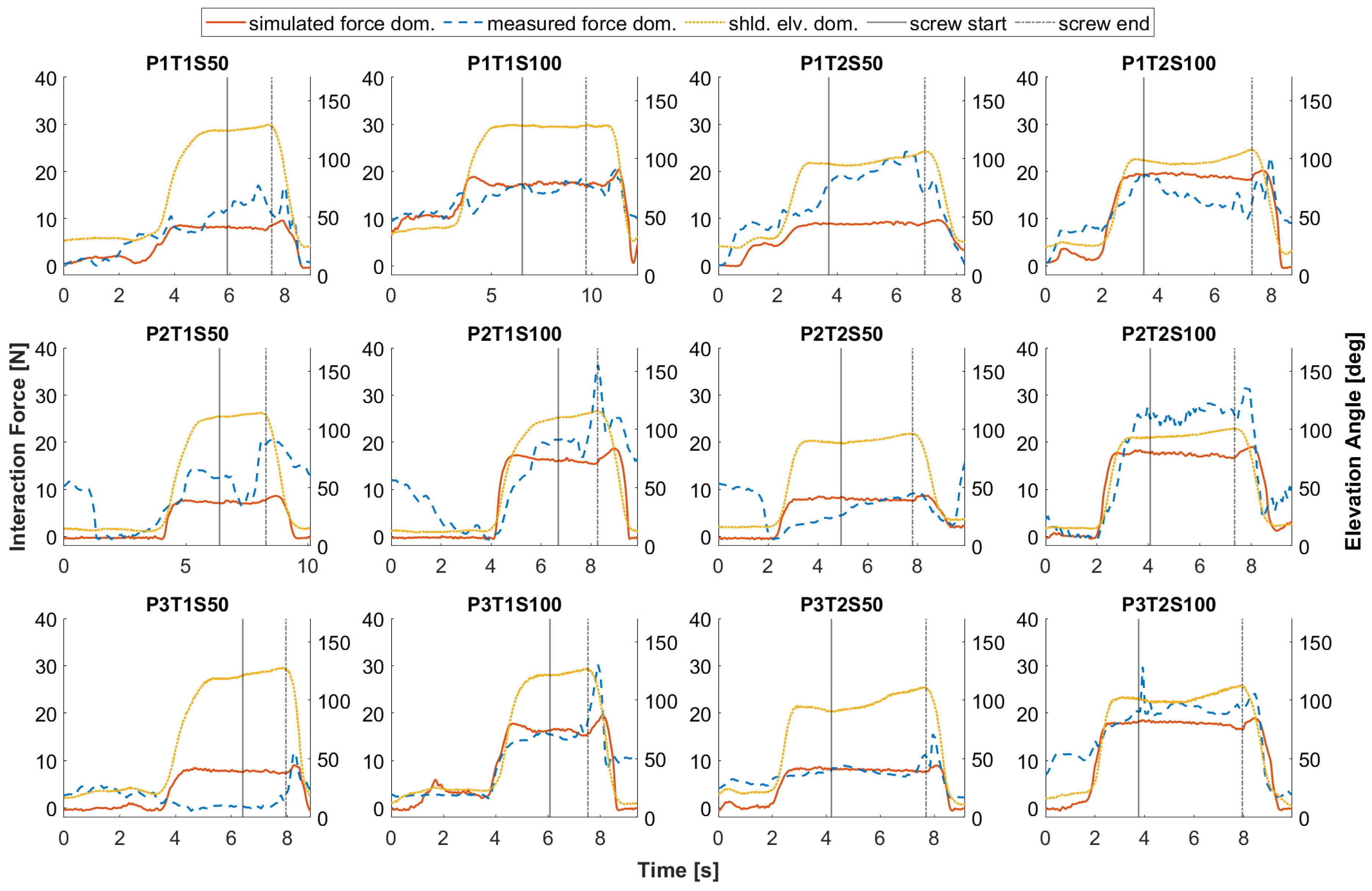
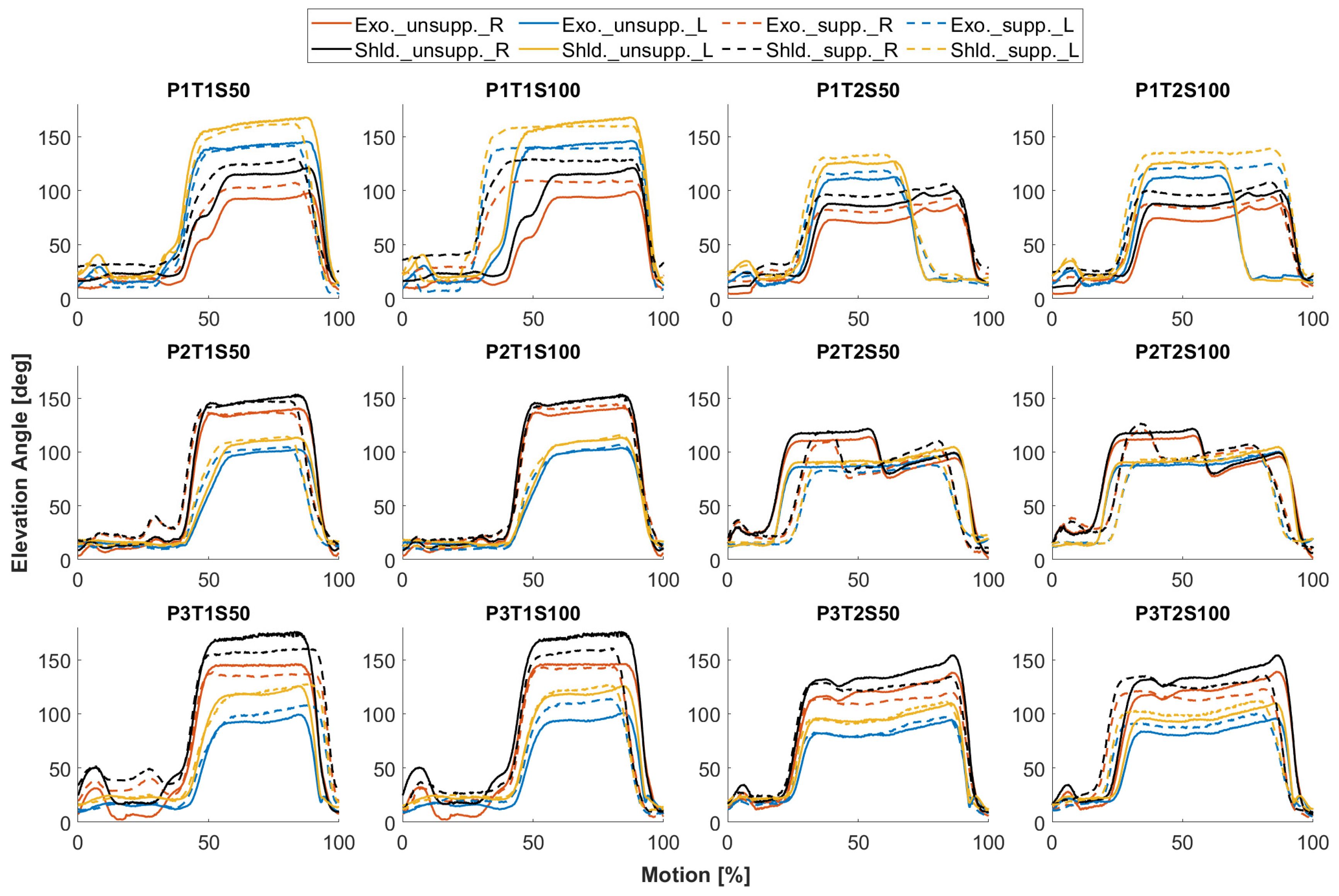
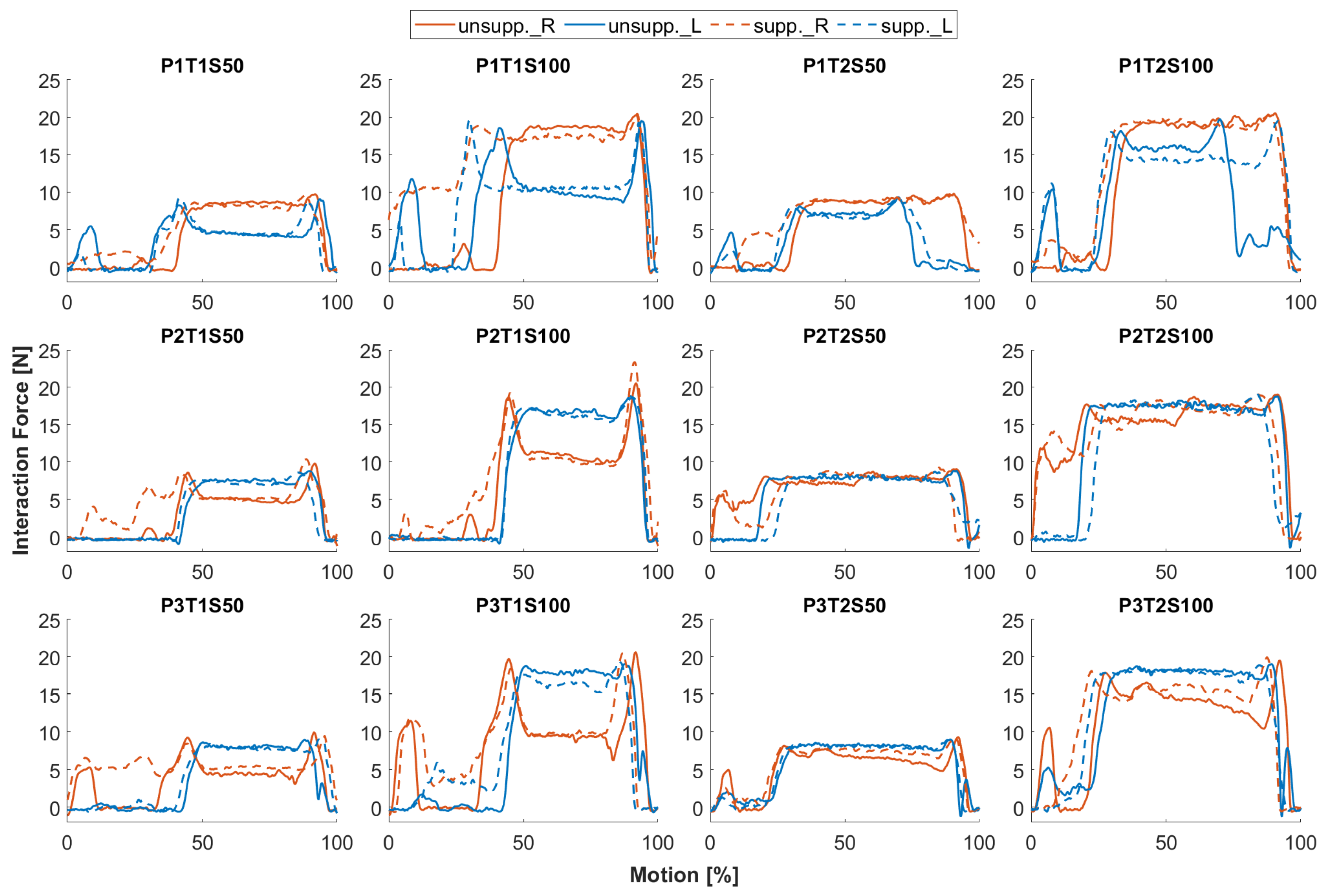
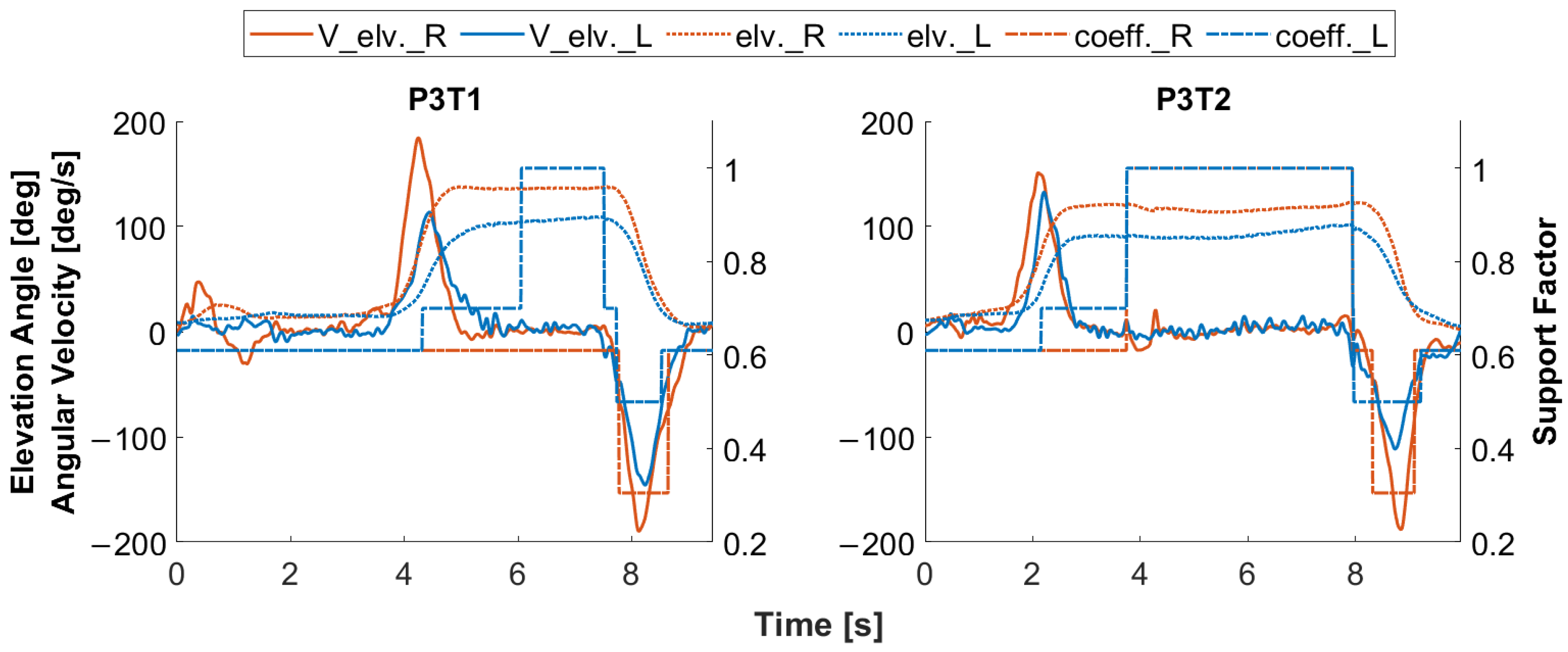
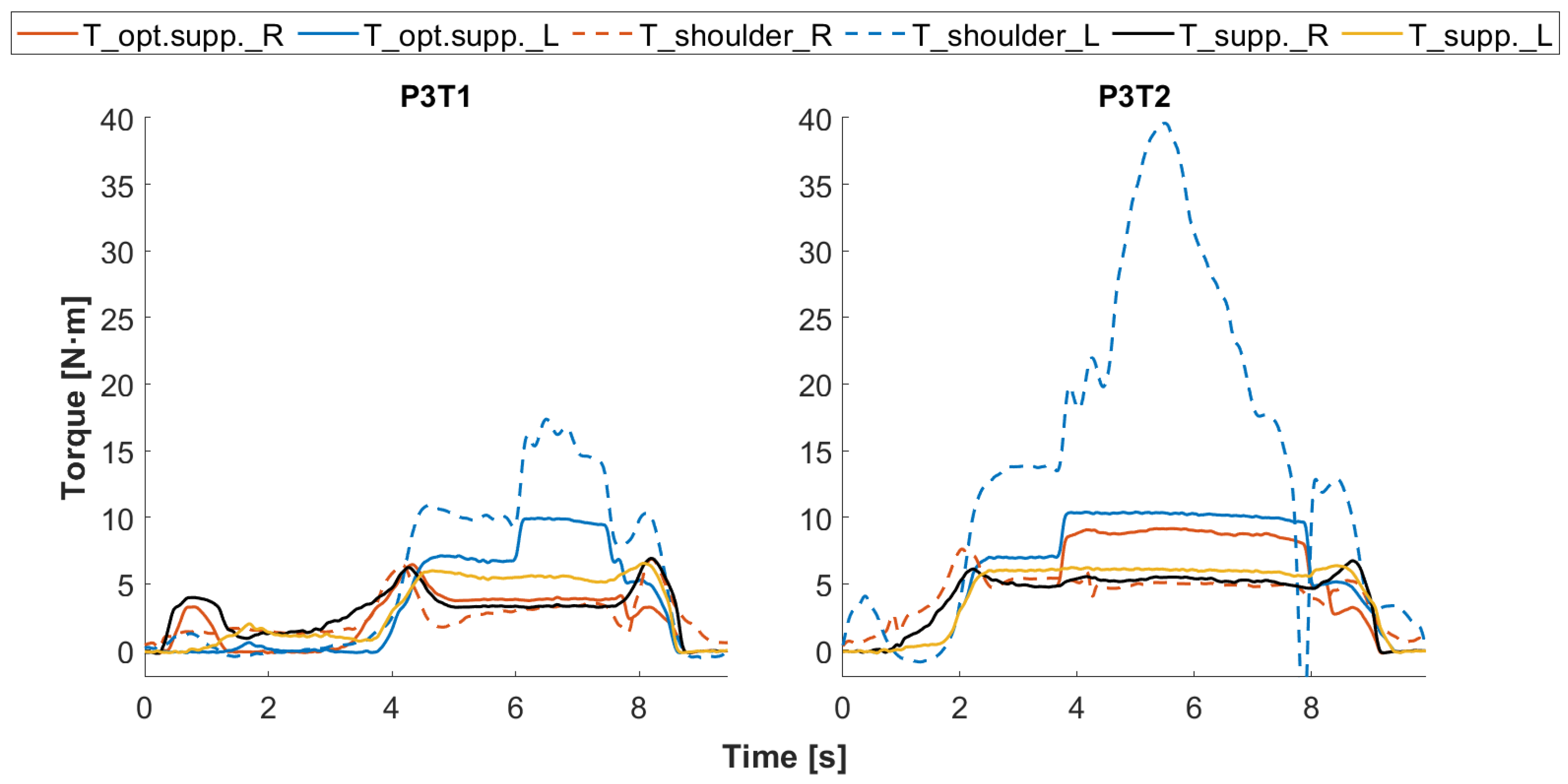
| Simulation Group 1 | Simulation Group 2 | |
|---|---|---|
| participants | P1–P3 | P1–P3 |
| tasks | T1, T2 | T1, T2 |
| support conditions | S50, S100 | S50, S100 |
| motion input | human motion from the respective supported conditions S50 and S100 | human motion from unsupported condition S0 |
| number of simulations | 12 | 12 |
| Validation Level 1 | Validation Level 2 | |
|---|---|---|
| research question | Is this approach able to reproduce the exoskeleton behavior in response to the human motion recorded with the support of the exoskeleton? | Is this approach suitable for exoskeleton simulation interaction based on human motion recorded without wearing the exoskeleton? |
| comparison group | simulated data based on supported conditions (S50/S100) vs. measured | simulated data based on unsupported (S0) vs. supported (S50/100) motion |
| compared variables |
|
|
| Arm Side | Dominant | Non-Dominant | ||||
|---|---|---|---|---|---|---|
| Work Phases | Lift | Screw-in | Lower | Lift | Screw-in | Lower |
| T1 | 0.6 | 1 | 0.3 | 0.6 | 0.6 | 0.3 |
| T2 | 0.7 | 1 | 0.5 | 0.7 | 1 | 0.5 |
Disclaimer/Publisher’s Note: The statements, opinions and data contained in all publications are solely those of the individual author(s) and contributor(s) and not of MDPI and/or the editor(s). MDPI and/or the editor(s) disclaim responsibility for any injury to people or property resulting from any ideas, methods, instructions or products referred to in the content. |
© 2024 by the authors. Licensee MDPI, Basel, Switzerland. This article is an open access article distributed under the terms and conditions of the Creative Commons Attribution (CC BY) license (https://creativecommons.org/licenses/by/4.0/).
Share and Cite
Yao, Z.; Mir Latifi, S.M.; Molz, C.; Scherb, D.; Löffelmann, C.; Sänger, J.; Miehling, J.; Wartzack, S.; Lindenmann, A.; Matthiesen, S.; et al. A Novel Approach to Simulating Realistic Exoskeleton Behavior in Response to Human Motion. Robotics 2024, 13, 27. https://doi.org/10.3390/robotics13020027
Yao Z, Mir Latifi SM, Molz C, Scherb D, Löffelmann C, Sänger J, Miehling J, Wartzack S, Lindenmann A, Matthiesen S, et al. A Novel Approach to Simulating Realistic Exoskeleton Behavior in Response to Human Motion. Robotics. 2024; 13(2):27. https://doi.org/10.3390/robotics13020027
Chicago/Turabian StyleYao, Zhejun, Seyed Milad Mir Latifi, Carla Molz, David Scherb, Christopher Löffelmann, Johannes Sänger, Jörg Miehling, Sandro Wartzack, Andreas Lindenmann, Sven Matthiesen, and et al. 2024. "A Novel Approach to Simulating Realistic Exoskeleton Behavior in Response to Human Motion" Robotics 13, no. 2: 27. https://doi.org/10.3390/robotics13020027
APA StyleYao, Z., Mir Latifi, S. M., Molz, C., Scherb, D., Löffelmann, C., Sänger, J., Miehling, J., Wartzack, S., Lindenmann, A., Matthiesen, S., & Weidner, R. (2024). A Novel Approach to Simulating Realistic Exoskeleton Behavior in Response to Human Motion. Robotics, 13(2), 27. https://doi.org/10.3390/robotics13020027






